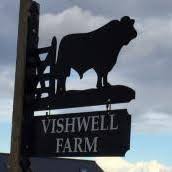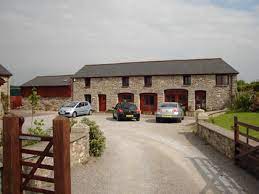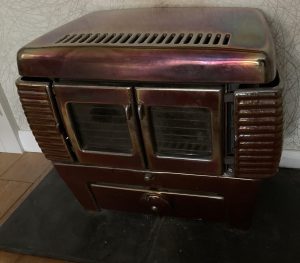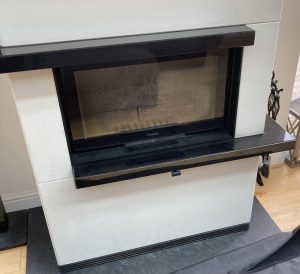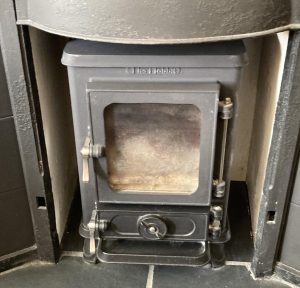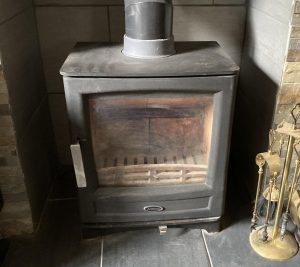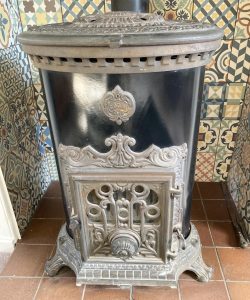 I recently swept this very unusual and attractive tall Petite Godin Stove at an address in Therfield near Royston. These antique stoves are quite a rare find these days, although I have come across one or two of these tall Petite Godin Stoves. I think these antique stoves are rather beautiful and in the right setting they can really add to the ambiance of a room and add value to a property. This stove was an admirable finishing touch to a snug room in an old, thatched cottage. I’m sure its presence means that the snug can be enjoyed by the family all year round! Looking on the internet they really hold their value and are now quite sought after, with a number of websites dealing with their acquisition and sale.
I recently swept this very unusual and attractive tall Petite Godin Stove at an address in Therfield near Royston. These antique stoves are quite a rare find these days, although I have come across one or two of these tall Petite Godin Stoves. I think these antique stoves are rather beautiful and in the right setting they can really add to the ambiance of a room and add value to a property. This stove was an admirable finishing touch to a snug room in an old, thatched cottage. I’m sure its presence means that the snug can be enjoyed by the family all year round! Looking on the internet they really hold their value and are now quite sought after, with a number of websites dealing with their acquisition and sale.
The Godin stove is the foundational of the history of French stove making, and indeed to the history of domestic stove manufacturing as a whole. Before the era of cast iron, domestic fuel took on many forms from the open hearth fire to the clay or stone kiln, but then the 23 year Godin started his business in 1840 making fireplaces in a shed in the centre of Thierache with a loan of about 4,000 francs from his parent, this quickly became too small.
The works soon moved to Guise where he started employing 30 people and in spite of fierce competition his business grew rapidly. The most important reason for this was his innovation. Godin applied for many patents for his products and concentrated on continually improving them both aesthetically and technically, making antique stoves from his era especially valuable.
Godin became a figure to know in French industrial relations. Godin offered his employees living wages or higher at a time of economic downturn, hired from a small pool of people in one geographical area reducing turn over and improving employee reliability.
By the end of the 1900’s, with a further 2000 employees, Godin was dominating the European stove market. Stove designs became ornate and stylised with the advent of the 20th century and the Art Nouveau and Art Deco movements. Godin’s stove design in this period did not become as elaborate and decorative as some other companies, such as Deville and Rosières, etc. But the stoves they produced in the early 20th century were, as always with Godin, extremely efficient and featured superb quality enamelling. Some of these original designs are still in production in the Godin factory today, laying testament to their design and efficiency.
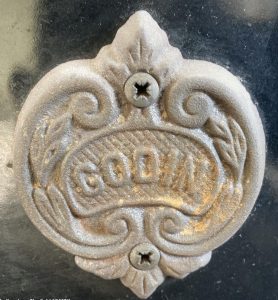
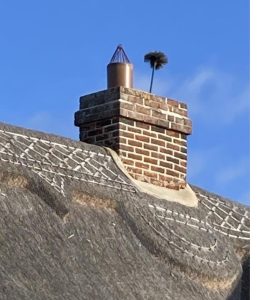
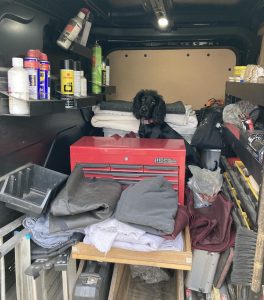 Here we were busy working at an address in Finchingfield doing the chimneys to a couple of large stoves, when we had a cheeky little visitor in the side compartment of the van. This was Poppy the customers little black Cocker Spaniel bitch, presumably on the hunt for some food, Cockers are known to be food obsessed life forms! “Yes, I’m checking out this van, I’m giving it a really good sniffing, but there is no food here”! Poppy is still quite young, not much over a year old, so she is still a pup really and the world is still such an exciting place, so who wouldn’t want to check out something new when it suddenly turns up on your driveway! The customer also have an old Chocolate Brown Labrador called Kato, who was being very well behaved and wasn’t going anywhere near the van and actually looked a bit sheepish, obviously concerned about what naughtiness his younger colleague was getting up to. They both did really make us laugh and brightened the working day.
Here we were busy working at an address in Finchingfield doing the chimneys to a couple of large stoves, when we had a cheeky little visitor in the side compartment of the van. This was Poppy the customers little black Cocker Spaniel bitch, presumably on the hunt for some food, Cockers are known to be food obsessed life forms! “Yes, I’m checking out this van, I’m giving it a really good sniffing, but there is no food here”! Poppy is still quite young, not much over a year old, so she is still a pup really and the world is still such an exciting place, so who wouldn’t want to check out something new when it suddenly turns up on your driveway! The customer also have an old Chocolate Brown Labrador called Kato, who was being very well behaved and wasn’t going anywhere near the van and actually looked a bit sheepish, obviously concerned about what naughtiness his younger colleague was getting up to. They both did really make us laugh and brightened the working day.

 My name is Paddy McKeown, I am a retired police officer (Detective Sergeant – Metropolitan Police), turned chimney sweep. I have completed training with ‘The Guild of Master Chimney Sweeps’, and Rod Tech UK (Power Sweeping).
My name is Paddy McKeown, I am a retired police officer (Detective Sergeant – Metropolitan Police), turned chimney sweep. I have completed training with ‘The Guild of Master Chimney Sweeps’, and Rod Tech UK (Power Sweeping).
 I recently swept this very unusual and attractive tall Petite Godin Stove at an address in Therfield near Royston. These antique stoves are quite a rare find these days, although I have come across one or two of these tall Petite Godin Stoves. I think these antique stoves are rather beautiful and in the right setting they can really add to the ambiance of a room and add value to a property. This stove was an admirable finishing touch to a snug room in an old, thatched cottage. I’m sure its presence means that the snug can be enjoyed by the family all year round! Looking on the internet they really hold their value and are now quite sought after, with a number of websites dealing with their acquisition and sale.
I recently swept this very unusual and attractive tall Petite Godin Stove at an address in Therfield near Royston. These antique stoves are quite a rare find these days, although I have come across one or two of these tall Petite Godin Stoves. I think these antique stoves are rather beautiful and in the right setting they can really add to the ambiance of a room and add value to a property. This stove was an admirable finishing touch to a snug room in an old, thatched cottage. I’m sure its presence means that the snug can be enjoyed by the family all year round! Looking on the internet they really hold their value and are now quite sought after, with a number of websites dealing with their acquisition and sale.


